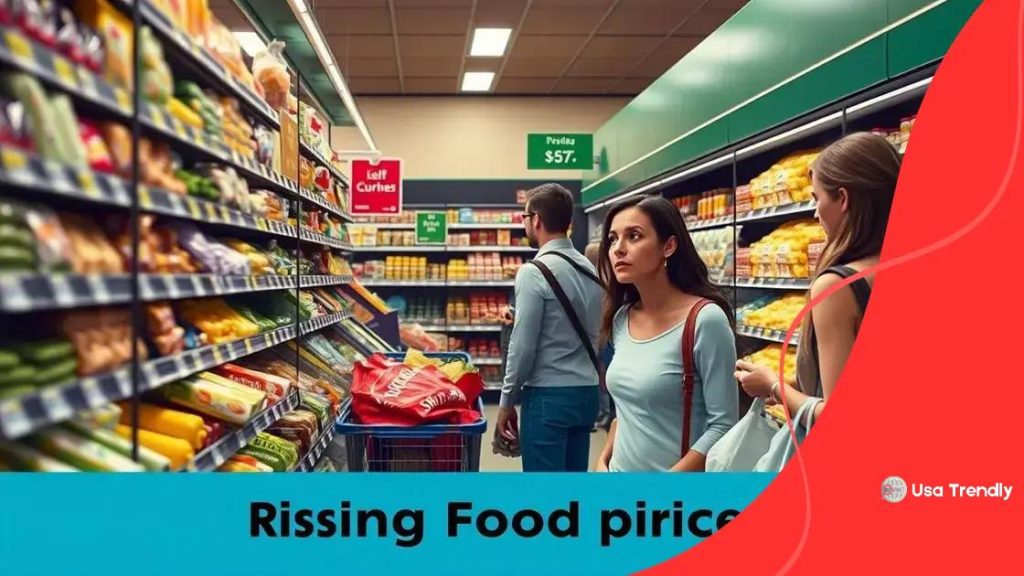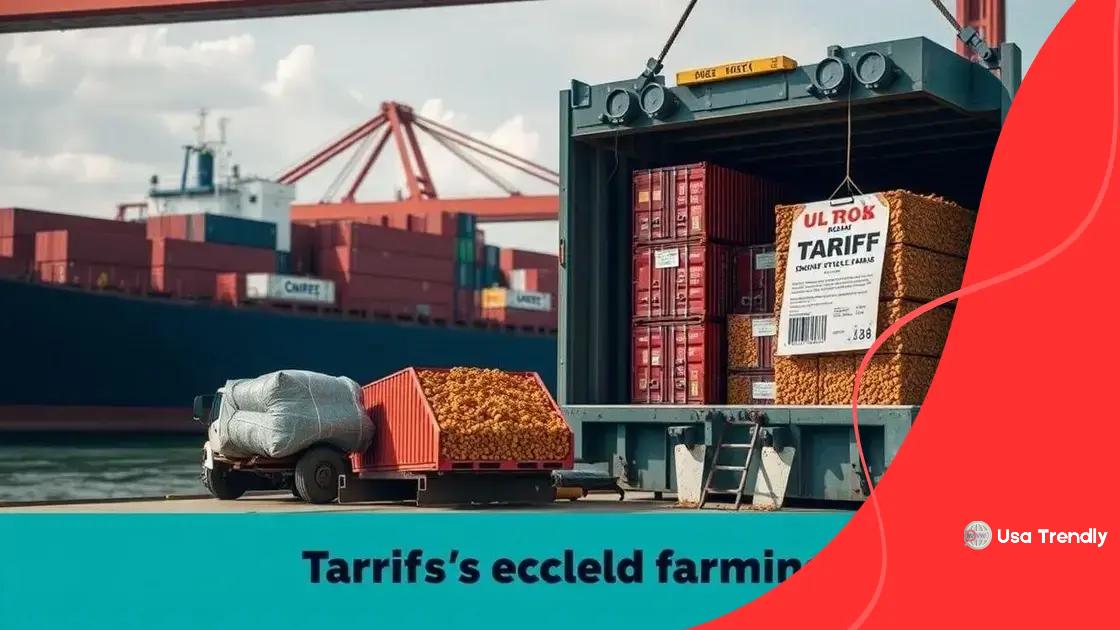Tariffs under Trump raise food expenses significantly

Tariffs under Trump raise food expenses by increasing the costs of imported goods, leading consumers to adjust their buying habits and prioritize essential items while affecting farmers and market dynamics.
Tariffs under Trump raise food expenses in ways many might not expect. You might be wondering, how do these tariffs lead to higher prices in grocery stores? Let’s break it down.
Understanding the impact of tariffs on food prices
When we think about price increases, one major factor comes to mind: tariffs. Understanding the impact of tariffs on food prices can help consumers make informed decisions. These tariffs can lead to higher food costs in many ways.
What are Tariffs?
Tariffs are taxes imposed on imported goods. They are designed to make foreign products more expensive, encouraging consumers to buy domestic products. This might sound good, but often it leads to increased costs for everyday items.
How Tariffs Affect Food Prices
When tariffs are implemented, the effects can ripple through the food supply chain. Higher costs on imported ingredients often mean that food manufacturers raise their prices. This means you might pay more at the grocery store.
- Increased costs for imported foods can lead to higher retail prices.
- Farmers who rely on imported materials may face increased production costs.
- Consumers may choose cheaper alternatives, which can affect food quality.
The impact on food prices gets complicated. For instance, if a country’s farmers have to pay more for their supplies, they often pass those costs onto consumers. This can make it harder for families to budget.
Consumer Reactions
As food prices rise, many consumers look for ways to adjust. Some change their shopping habits, while others seek out local options to cut costs. Understanding these shifts can inform both consumers and businesses.
- Many families start buying bulk to save money.
- Local farmers’ markets often see an increase in shoppers.
- Couponing and sales hunting become more prevalent.
Ultimately, it’s essential to be aware of how tariffs can shape your grocery bill. Staying informed might help you navigate the rising prices better. A little knowledge can go a long way!
Economic reasons behind Trump’s tariff policies
The economic reasons behind Trump’s tariff policies are driven by the desire to protect American industries. Tariffs are meant to encourage consumers to buy domestic products instead of foreign ones. This can boost local jobs and support the economy.
Protecting American Jobs
One of the main goals of implementing tariffs is to protect American jobs. By increasing the cost of imported goods, the hope is that consumers will turn to American-made products. This shift can help keep jobs in the country and prevent outsourcing of jobs to other nations.
Balancing Trade Deficits
Another economic reason is to address trade deficits. When a country imports more than it exports, it creates a trade imbalance. Trump’s administration believed that imposing tariffs would help reduce this deficit by making imports more expensive.
- Tariffs raise costs for foreign goods, encouraging local purchases.
- Reducing imports can help stimulate domestic production.
- Increased exports may lead to better global market positions.
These tariffs can actually change the economic landscape. Manufacturers may feel more secure knowing that their products are not facing as much competition. This can lead to increased investment and growth within U.S. industries.
International Relations and Negotiations
Tariffs also play a role in shaping international relations. By imposing tariffs, the U.S. sends a strong message about its trade priorities. This can lead to negotiations that aim for fairer trade deals. Countries are often forced to reconsider their practices to maintain good trade relations with the U.S.
- Strong tariffs can pressure other countries to renegotiate trade agreements.
- International negotiations often revolve around tariff adjustments.
- Trade balance can strengthen diplomatic relations.
In summary, the economic reasons behind Trump’s tariff policies focus on protecting U.S. jobs and addressing trade imbalances. Understanding these factors helps to clarify the reasoning behind such significant policy changes.
How tariffs affect agricultural imports

Understanding how tariffs affect agricultural imports is critical for grasping their broader economic influence. Tariffs impose taxes on imported agricultural products, which can lead to increased prices for consumers.
Impact on Prices
When tariffs are applied, the cost of imported agricultural goods rises. This can lead to higher prices in grocery stores and affect everything from grains to fresh produce. Farmers producing these goods might find their products costing significantly more, which can be both a burden and a protection.
Effects on Domestic Agriculture
With higher tariffs on imports, American farmers may benefit. Domestic products become more competitive as imported goods get pricier. This can boost local production but also create challenges if farmers rely on imported supplies or seeds.
- Increased demand for local products as imports rise in price.
- Potential for enhanced local agricultural jobs.
- Risks of retaliatory tariffs from other countries affecting exports.
The landscape of agriculture may undergo significant changes due to tariffs. Farmers might reconsider their planting strategies or shift their focus to crops that can compete better in a more protected market.
Trade Relationships
Tariffs can alter international trade dynamics. Countries impacted by U.S. tariffs may respond by increasing their own tariffs on American goods. This can strain trade relationships and affect exports, creating a cycle of increasing costs.
- Potential disruptions in trade networks can lead to food shortages or surpluses.
- International markets can be destabilized as countries retaliate.
- Farmers may need to seek new markets or adjust to changing supply chains.
Ultimately, while tariffs are designed to protect U.S. agriculture, they can create challenges and opportunities that farmers must navigate carefully. Staying informed about these changes is essential for both producers and consumers alike.
Consumer responses to rising food costs
Consumer responses to rising food costs can vary greatly, but many people share similar strategies to cope. When food prices increase, shoppers often feel the financial strain and look for ways to adjust their habits.
Changing Shopping Habits
One common response to rising prices is to change shopping habits. Many consumers become more price-conscious. They may start looking for discounts, using coupons, or switching to cheaper brands. This behavior can lead to a heightened awareness of the prices of everyday items.
Prioritizing Essentials
As food costs rise, consumers often prioritize essential items. Instead of purchasing luxury or non-essential foods, families may focus on basic products like grains, fruits, and vegetables. This shift can lead to changes in dietary habits, with a focus on cost-effective nutrition.
- Increased demand for simple, healthy ingredients.
- More people cooking at home to save money.
- Reduced consumption of processed and convenience foods.
Many consumers also begin meal planning to ensure they use what they buy, reducing food waste. By carefully planning meals based on sales and seasonal items, families can save money and still eat healthily.
Exploring Alternative Options
Some families explore alternative options like local farmers’ markets or community-supported agriculture programs. These options can provide fresh produce at a lower cost. Additionally, bulk buying becomes more popular as it allows consumers to stock up on staple items at a lower price per unit.
- Farmers’ markets can offer competitive prices and fresh produce.
- Buying in bulk can help reduce the cost of staples.
- Community gardens provide access to affordable food sources.
As food costs continue to rise, understanding how consumers respond can provide insights into changing market dynamics. Adjusting habits not only helps families manage budgets but also impacts food industry trends.
The future of food prices in light of ongoing tariffs
The future of food prices in light of ongoing tariffs is uncertain, yet critical to understand. As tariffs remain imposed, they continue to influence food markets and consumer spending.
Predicting Price Trends
Current economic models suggest that food prices may remain elevated over the coming years. With tariffs increasing the cost of imported goods, consumers may see sustained higher prices. This situation could alter buying habits and affect food affordability.
Potential Market Adjustments
As manufacturers and retailers adapt to these changes, they may look for strategies to offset higher costs. Some might source ingredients from alternative suppliers or invest in local production. This shift can lead to changes in the availability of certain products.
- Retailers may promote local products to attract consumers.
- Farmers might change crops based on demand and pricing.
- Innovations in agricultural practices may become necessary to stay competitive.
Consumers will also likely adapt their buying patterns in response to ongoing tariffs. Many people might seek out sales, discounts, or switch to lower-cost alternatives. These changes can lead to a more price-sensitive market, where consumers favor affordability over brand loyalty.
The Role of Policy Changes
Future changes in trade policy can also impact food prices. If tariffs are lowered or removed, we could see prices drop. Conversely, if new tariffs are introduced, costs may rise further. The constant fluctuation in trade relations means that stakeholders must remain vigilant.
- Potential new trade agreements could stabilize prices.
- Changes in global market demand affect food supply costs.
- Government subsidies may play a role in managing prices.
Overall, the landscape of food pricing is complex. By keeping track of how ongoing tariffs affect market dynamics, consumers and producers alike can make informed decisions about the future.
FAQ – Frequently Asked Questions about Food Prices and Tariffs
How do tariffs affect food prices?
Tariffs make imported foods more expensive, which leads to higher prices for consumers at grocery stores.
What strategies can consumers use to cope with rising food costs?
Consumers may look for discounts, prioritize necessities, and explore local farmers’ markets to save money.
How might farmers adjust their practices due to tariffs?
Farmers might change their crop production strategies and focus on local sourcing to remain competitive.
What role do government policies play in food pricing?
Changes in trade agreements and tariffs can significantly impact food prices, influencing market dynamics and consumer behavior.
SEE MORE CONTENT